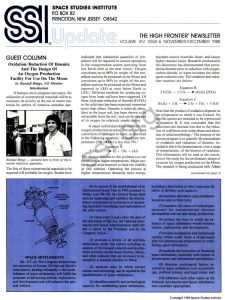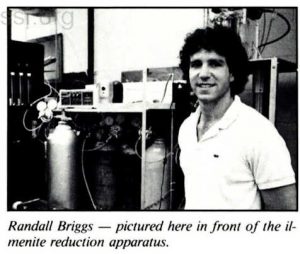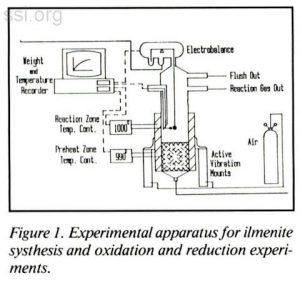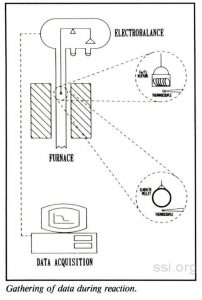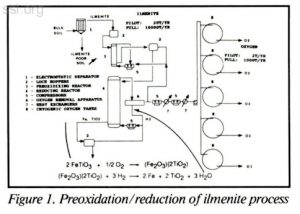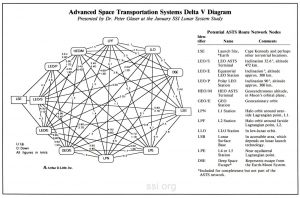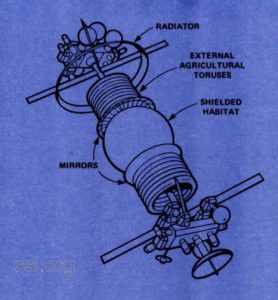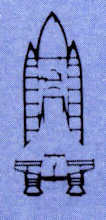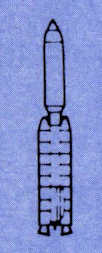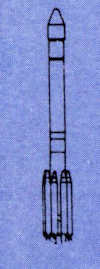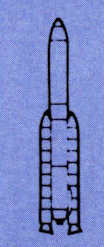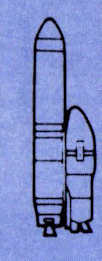SPACE STUDIES INSTITUTE
P.O. BOX 82
PRINCETON, NEW JERSEY 08542
[[librarian note: This address is here, as it was in the original printed newsletter, for historical reasons. It is no longer the physical address of SSI. For contributions, please see this page]]
SSI UPDATE
THE HIGH FRONTIER® NEWSLETTER
VOLUME XIV ISSUE 6
NOVEMBER/DECEMBER 1988
GUEST COLUMN
Oxidation/Reduction Of Ilmenite And The Design Of
An Oxygen Production Facility For Use On The Moon
by Randall Briggs, SSI Member
Introduction
If humans are to progress into space, the utilization of nonterrestrial materials will be as necessary an activity as the use of native materials by settlers of America centuries ago.
The first of these nonterrestrial materials to be acquired will probably be oxygen. Studies have indicated that substantial quantities of propellant will be required to sustain operations in the transportation system operating from low Earth orbit in the near future.[1] Oxygen constitutes up to 86% by weight of this propellant and may be produced on the Moon and constitutes up to 86% by weight of this propellant and may be produced on the Moon and exported to LEO at costs below Earth to LEO.[2] Different methods for producing oxygen from lunar soil have been suggested. Of these, hydrogen reduction of ilmenite (FeTi03) in the solid state has been examined somewhat more than others. Ilmenite is relatively abundant in the lunar soil, has been shown to be extractable from the soil,[3] and can be stripped of its oxygen by relatively simple means.
A major technical problem confronts this oxygen production process. The low per pass conversion of hydrogen to water, as described in the following equation, 1 at moderate temperatures (700-1OOOK) is less than 5%.[4]
Equation A:
FeTiO3 + → Fe + Ti02 + H2O
The obvious solution to this problem is to run the process at higher temperatures. Major problems may arise however to limit the viability of this solution. Operating the process at higher temperatures demands more energy, degrades reactor materials faster, and causes higher reactant losses. Research conducted in this laboratory has demonstrated that preoxidizing ilmenite prior to reduction with oxygen, carbon dioxide, or water increases the subsequent reduction rate. The oxidation and reduction reactions are shown:
Equation B:
2 FeTiO3 + 1/2 02 → (Fe203) (2Ti02)
Equation C:
(Fe203) + 3 H2 → 2Fe + Ti02 + 3 H2O
Note that the product of oxidation depends on the temperature at which it was formed. No specific species are intended to be represented in equation B. It was concluded that this reduction rate increase was due to the reduction of a different iron oxide phase and alteration of solid morphology.[5] The purpose of the current program is to quantify the mechanisms of oxidation and reduction of ilmenite. Included in this is the determination, over a range of temperatures, of the kinetics of reactions. This information will be used at the conclusion of the study for the preliminary design of a reactor for oxygen production on the Moon. The research is being conducted with Albert Sacco, Jr. in the chemical engineering department at Worcester Polytechnic Institute in Worcester, Massachusetts.
Laboratory Studies
To determine the mechanisms of lunar ilmenite reduction and the sizing of the reactor system for use of the Moon, the use of lunar analog ilmenite is essential. As terrestrial ilmenite is contaminated with ferric iron (Fe+3) not found in lunar ilmenite, and its presence substantially affects how the mineral reduces,[6] synthesis of lunar analog ilmenite is undertaken. Experimental samples of ilmenite, once synthesized, are reacted in a quartz tube reactor system displayed in Figure 1. By monitoring the weight of samples as reaction gases pass over, the extent of reduction (according to equations A or B) or oxidation (equation C) is determined. The experimental conditions of reaction are important, thus instrument precision is critical. The temperature of the sample is maintained within ± 1°K up to 1373 °K and the sample weight is monitored with a sensitivity of 10-7 grams. In addition to these thermogravimetric studies, additional examinations are undertaken during the study of reaction mechanism. Scanning electron microscopy is used to examine the history of the solid phase morphology. X-ray diffraction is used to identify products of reaction. X-ray dispersive spectroscopy is used to map the location of elements in the solid phase. Using all these techniques, modeling of the reaction process is then undertaken to test proposed theories on the mechanisms of oxidation and reduction. These mathematical models, representing reaction progress, are developed to quantify the roles played by kinetics, solid state diffusion, as well as other mechanisms that may dictate how ilmenite is oxidized and reduced. Only after these mechanisms are completely understood can the type of reactor to best accomplish the project’s goals be selected. With an understanding of the rates of reactions, the reactor size can be estimated to achieve the desired production rate of oxygen. These determinations ultimately lead to the issues of process mass, energy needs, and the complexity of the process.
Program Future
Elucidation of the mechanisms of ilmenite reduction is currently in progress. Design of a reactor system based upon these mechanisms will be undertaken in the near future. Important in the design phase of the program is an examination of the effects of reduced gravity on reactor size and the testing of proposed mechanisms on a semicontinuous, bench-scale level. Future work along these avenues is currently being discussed. Perhaps the most interesting studies to be conducted in the future, aside from oxygen production, are related to the solid products of reduction. Iron, almost 40% of the original mass of the ilmenite, remains behind, “locked up,” in a Ti02 matrix. Preparations to examine potential extraction schemes are currently underway. Ultimately, iron may be as useful as oxygen, even in the near term, as it can provide the basic building blocks of space construction. Thus, the future of the current program is the natural progression to the next logical step the production of iron from ilmenite.
1. Driggers, C. W. (1976) Abstract in Lunar Science VII, pp 26-34, Lunar Science Institute Sakeld, R.J . (1966) J. Spacecraft and Rockets, 3, 254-261
3. Agosto, W. (1985) Lunar Bases and Space Activities of the 21st Century, pp 453-464
4. Williams, R.J. (1985) Lunar Bases and Space Activities of the 21st Century, pp 551-558
5. Briggs, R.A. and Sacco, A. (1986) BS thesis, Department of Chemical Engineering, Worcester MA
6. Briggs, R.A. and Williams, R.J. (1986), Abstract in Lunar and Planetary Institute Intern Conference II, pp 7-8
Processing Lunar Soil and its Use in Future Near-Earth Activities:
Ideas Generated by the Commercial Development Team at the 1988 Summer Session of the International Space University
by Randall Briggs
The development of a set of processing activities in the layout of an evolving lunar base cannot be an independent consideration conducted by chemical engineers. During the 1988 summer session of the International Space University the Commercial Development team, directed by Gregg Maryniak, was charged with the responsibility of developing such a set of activities. Commercial Development interfaced with research groups concerned with other aspects of lunar base development such as Earth-Moon transportation, business and management of commercial operations, environmental impact of surface activities, and surface power supply. This group matrix allowed for an interdisciplinary approach to the design of a future lunar base.
The International Space University (ISU) assembled 104 individuals from over 20 countries to the campus of MIT for nine weeks. The participants were selected to form eight specialty areas including space science, space engineering, resources and manufacturing, architecture, business and management, space policy and law, life sciences, and satellite applications. From these areas, participants were grouped into working teams for the design of a privately operated lunar base. I had the opportunity to participate on the Commercial Development team. This brief article will discuss the outcome of the Commercial Development group and its relationship with other teams.
GROUP DYNAMICS
The goal of the Commercial Development group was to generate ideas for profitable lunar activities. This included examining the means of producing raw materials from lunar soil and determining the means of manufacturing items from these raw materials. To achieve these goals the Commercial Development group received input from a variety of other research teams working on other aspects of the lunar base design. This aspect of the ISU lunar base project set it apart from most others – it was interdisciplinary in its approach. When Commercial Development needed to know of the lawfulness of proposed activities it consulted Space Policy and Law. When the funding schedule needed to be clarified it consulted Business and Management. How much energy could it demand from Surface Operations? Meetings were set up to discuss this critical component of design. How much launch mass could it extract from space transportation? Discussions with the transportation team hammered out a launch schedule. Were we operating acitivities within the guidelines set forth by the Environmental Impact team? Did activities interfere with the needs of the Lunar Science group? Through an iterative process of group meetings/interface meetings among groups/group meetings, the lunar base design was arrived at. Each iteration brought to focus the questions each group needed answered by other groups. When important questions arose that no group had addressed, spontaneous “tiger teams” arose, resolved the issue, and dissolved.
SUMMARY OF RESULTS
What can be done on the lunar surface to create enough capital to fund the deployment of a lunar base? Although at the outset of the project the power from a 5 GW solar power satellite in geostationary orbit was described as a guaranteed revenue to the base operators, by the project’s midway point no one choice of manufacturing or servicing activity was seen capable of providing enough profit to make the return to the Moon economically feasible for a private firm. Instead, a phasing approach to funding lunar activities was described by the project’s business group. The project funding would be provided initially by participating governments and over the course of twenty years progress into a private operation. With this funding approach in mind, the philosophy promoted by the Commercial Development group was one of even, steady advancement of knowledge with regard to operating processes on the Moon at the pilot plant level and subsequently on a full scale operational level.
The processes for the acquisition of raw materials from lunar soil and the manufacturing of useful items were deployed in a stepwise fashion. Compromises between desirability of material, plant mass and transportation constraints, and process energy demands and surface energy supplies were carefully balanced within the capabilities and constraints developed by other research teams. The deployment schedule of pilot plants with estimated mass and energy demands are listed in Table 1.
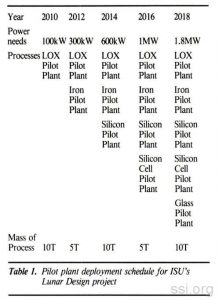
A similar table for the deployment of full scale activities is shown in Table 2. To estimate plant output and thus plant sizing it was assumed the processing operations would begin supplying the material needs of a demonstration solar power satellite in geostationary orbit by the year 2035-2040.
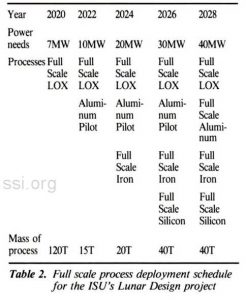
To describe the layout of Table 1, examine the column for year 2014. In this year a pilot silicon production plant is deployed to begin operating alongside a previously operating pilot liquid oxygen (LOX) plant and iron production pilot plant. The mass of the silicon plant was estimated to be approximately 10 metric tons (10T) and was estimated to require approximately 300kW (600kW – 300kW). The development of the pilot plant deployment schedule was arrived at through the examination of individual production facilities for each material made.
As an example of these examinations, Figure 1 shows an overview of the liquid oxygen production plant. The plant employs a preoxidation/reduction process to obtain oxygen from lunar ilmenite (FeTi03). Once the layout was designed, estimates of mass and energy requirements for the process were made. The mass and energy demands for the LOX pilot plant were estimated for the production of approximately 2-4 tons/year on a 200 day/year operating schedule. Note that the mass and power supplies for the mining operations are included in the first process described in both Tables 1 and 2. With a rudimentary understanding of the complexity of individual processes, their mass and energy demands, as well as the capabilities the surface energy supplies and the space transportation system, the deployment schedules shown in Tables 1 and 2 were arrived at.
Guiding the overall approach to this scheduling was the desire to maximize base flexibility by the year 2035. The goal of the operations was to have the capability of supplying material and services to any market in the Earth-Moon system. Note that the summer session allowed for no more than a review of current literature of proposed processes. Except in the very rare case, no experimental data to verify the claims of these proposed processes existed. No time was available to verify the claims independently during the project. Thus, the mass and energy demands used in the layout of the process plants are suspect and probably valid only within half an order of magnitude.
FINAL REPORT
The final report from the 1988 Summer session of the International Space University is currently being compiled. The interdisciplinary and international background of the ISU participants provided a unique approach to the lunar base design project. The strategy of attempting to privatize the effort was also a unique aspect of this study. By working together the nations of the world may one day find the ability to undertake a return to the Moon in a manner discussed during the ISU. Conducted on an international level, the commitment from individual nations can be lowered. Furthermore, the intangible returns experienced by the 104 participants in the 1988 project could be extended to the citizens of those nations involved.
Sec. 217.(a) The Congress declares that the extension of human life beyond Earth’s atmosphere, leading ultimately to the establishment of space settlements, will fulfill the purposes of advancing science, exploration, and development and will enhance the general welfare.
(b) In pursuit of the establishment of an International Space Year in 1992 pursuant to Public Law 99-170, the United States shall exercise leadership and mobilize the international community in furtherance of increasing mankind’s knowledge and exploration of the solar system.
(c) Once every 2 years after the date of the enactment of this Act, the National Aeronautics and Space Administration shall submit a report to the President and to the Congress which
(1) provides a review of all activities undertaken under this section including an analysis of the research and development activities on the Space Station, Moon, and other outposts that are necessary to accomplish a manned mission to Mars;
(2) analyzes ways in which current science and technology can be applied in the establishment of space settlements;
(3) identifies scientific and technological capacity for establishing space settlements, including a description of what steps must be taken to develop such capacity;
(4) examines alternative space settlement locations and architectures;
(5) examines the status of technologies necessary for extraterrestrial resource development and use and energy production;
(6) reviews the ways in which the existence of space settlements would enhance science, exploration, and development;
(7) reviews mechanisms and institutional options which could foster a broad-based plan for international cooperation in establishing space settlements;
(8) analyzes the economics of financing space settlements, especially with respect to private sector and international participation;
(9) discusses sociological factors involved in space settlement such as psychology, political science, and legal issues; and
(10) addresses such other topics as the National Aeronautics and Space Administration considers appropriate.
9th SSI/PRINCETON CONFERENCE ON SPACE MANUFACTURING
MAY 10-13, 1989
The 9th Biennial SSI/Princeton Conference on Space Manufacturing, sponsored by Space Studies Institute, is a forum for papers on all aspects of the use of nonterrestrial resources. The program includes papers both on technical aspects of space development and on the social sciences.
In order to accommodate a broad range of presentations, two different types of presentations will be encouraged: 1) the traditional presentation of papers in the auditorium at the Woodrow Wilson School, 2) a poster session and display.
The first three days of the Conference will be open only to registered participants. A summary session on Saturday, May 13 is free and open to all.
SUBMISSION OF ABSTRACTS
Abstracts of papers received by January 15, 1989 will be considered for inclusion in this Conference. Please limit abstracts to one page with no references.
Abstracts and other inquiries should be sent to:
Ms. Barbara Faughnan
Conference Coordinator
Space Studies Institute
P.O. Box 82, Princeton, NJ 08542
PEER REVIEW
Voluntary peer review is available. Papers submitted for peer review must be received in entirety by January 15, 1989.
Authors will receive reviewers’ comments for their own information only. Papers will not be accepted or rejected on the basis of peer review.
REGISTRATION INFORMATION
Registration is available by mail or phone through the Space Studies Institute. Please contact Barbara Faughnan at xxx-xxx-xxxx for details.
CONFERENCE PROGRAM
Following is a listing of sessions, chairmen and a brief description of the content matter scheduled for this year’s Space Manufacturing Conference:
Woodrow Wilson School
Princeton University
Wednesday, May 10
8:30 am Registration
8:45 am Introductory Remarks:
Gerard K. O’Neill,
President Space Studies Institute
9:00 am Welcoming Remarks: Hon. Robert C. Torricelli
U.S. Congress (D.-N.J.)
9:10 am Keynote Address:
John Aaron,
Acting Assistant Administrator for Exploration National Aeronautics and Space Administration
9:40 am Session I
EXTERNAL TANKS AND SPACE HABITATS
Co-chairs: Faye Bailiff and Tom Mobley
Martin Marietta
The Presidential Space Policy directive of January 1988 provides that external tanks will be provided to organizations for use in space. This session will examine the most readily available type of nonterrestrial resource, the Shuttle’s large external tank.
2:30 pm Session II
SPACE BIOSPHERES Chair: Mark Nelson
Institute of Ecotechnics
Robust closed-cycle systems are essential if we are to sever the umbilical cord to the Earth in future space missions. This session will examine closed cycle life support and the creation of true biospheres in space.
Thursday, May 11
9:00 am Session III
SPACE MANUFACTURING AND SPACE POWER
Chair: Peter Glaser,
Arthur D. Little Company
This session will discuss the design, transportation and construction of large systems in space, in particular those having to do with the production transmission and utilization of energy. Robotic and automatic techniques will be advised.
1:30 pm Session IV
INTERNATIONAL AND ECONOMIC CONSIDERATIONS
Chair: Irwin Pikus
U.S. Department of Commerce
This session will include discussion of economic factors and implications of international space development.
3:15 pm Session V
NONTERRESTRIAL
RESOURCES
Chair: John Lewis
Lunar and Planetary Laboratory
This session will examine advancements in the location, utilization, mining, extraction and use of extraterrestrial materials
6:00 pm POSTER SESSION
Chair: James Burke
Jet Propulsion Laboratory
Poster topics will cover a wide range of disciplines. These will be highlighted at a special wine and cheese reception.
7:00 pm LUNAR POLAR PROBE
Chair: Gay E. Canough
ExtraTerrestrial Materials, Inc.
This session will summarize the results of SSI’s two day workshop on small robotic lunar probes which immediately precedes the conference.
Friday, May 12
9:00 am Session VI
SPACE TRANSPORTATION
Chair: Ed Bock General Dynamics
This session will cover recent developments in new and conventional types of space vehicles and transportation systems.
1:30 pm Session VII
BIOMEDICAL CONSIDERATIONS
Chair: James Logan
NASA Headquarters
Biological and physiological aspects of longterm missions are now recognized as being as important as propulsion and basic engineering for spaceflight. This session will examine the problems of micro-gravity and low gravity environments, radiation shielding and other topics.
Ramada Hotel, Princeton, NJ
6:00 pm Reception
7:00 pm Banquet
Guest Speaker: Robert J. Cenker Payload Specialist/Astronaut
Woodrow Wilson School
Princeton University
Saturday, May 13
9:00 am Summary Session
Each chairman will present a summary of the papers within their session.
Space Studies Institute, Rocky Hill, NJ
12:30 pm Box Lunch Picnic
Informal gathering of Conference participants and Senior Associates of the Institute. Tickets for this event may be purchased through the Institute or during the Conference at the Registration Table.
LAUNCH OPTIONS FOR THE FUTURE
Existing Systems
Space Shuttle – a piloted, partially reusable launch vehicle capable of lifting about 48,000 pounds to lowEarth orbit (LEO). The Shuttle fleet now consists of three orbiters; a fourth is on order. The Shuttle had completed 24 flights successfully prior to the loss of the orbiter Challenger in January 1986.
Titan IV – an expendable launch vehicle (ELV) manufactured by Martin Marietta Corporation, which can lift 39,000 pounds of payload to LEO. This vehicle will be launched for the first time later this year, and will be the Nation’s highest capacity existing ELV.
Medium Launch Vehicle – either a Delta II manufactured by McDonnell Douglas, with a lift capability of 7,600 pounds to LEO; or an Atlas Centaur II manufactured by General Dynamics with a lift capacity of about 13,500 pounds to LEO.
Shuttle-C – an unpiloted cargo vehicle, derived from the Shuttle, with a heavy lift capacity of 100,000 to 150,000 pounds to LEO. It would use the existing expendable External Tank and reusable Solid Rocket Boosters of the current Shuttle, but would replace the orbiter with an expendable cargo carrier.
Shuttle II – a fully reusable piloted launch vehicle derived from the current Shuttle. Althought Shuttle II is not a firm concept, OTA assumes that it could carry payloads comparable to those carried by the Shuttle but that it would be less costly to operate.
Titan V – a heavy lift ELV derived from the Titan IV. Its payload capacity could range from 60,000 to 150,000 pounds to LEO.
Transition Vehicle – a partially reusable unpiloted launch vehicle with recoverable engines designed to be built with existing technology.
Advanced Launch System (ALS) – a totally new launch system under study by the Air Force and NASA that would be designed to launch large cargo payloads economically at high launch rates. OTA assumes a partially reusable vehicle featuring a flyback booster, a core stage with expendable tanks and payload fairing, and a recoverable payload/avionics module.
VICE PRESIDENT’S COLUMN
Progress Toward The High Frontier
Thanks to your help and support we have lots of exciting progress to report in this issue. Many exciting developments are taking place in both the private and public sectors.
Space Colonization – not just a good idea, it’s the law!
I am delighted to report that the Space Settlement Act proposed by Congressman George Brown of California has been passed by the Senate in the past few days and reported to the President for signature. The Act was made part of the NASA authorization bill and it is virtually certain to have the force of law by the time you read these words. The Act will require NASA to provide biennial reports to the President and Congress on progress technologies required for nonterrestrial development and energy production. In the Act, Congress specifically declares that “the extension of human life beyond Earth’s atmosphere leading ultimately to the establishment of space settlements will fulfill the purposes of advancing science, exploration and development and will enhance the general welfare.”
Passage of this language follows testimony and Congressional hearings by NASA, industry and present and former officers of the Space Studies Institute. While the new legislation does not create a space settlement program establishing direction and blessing research towards the opening of the High Frontier. (See box Page 1.)
Hail Discovery!
Congratulations to the crew of Discovery and NASA on the re-establishment of American manned space flight. The Institute’s staff and I watched with great anticipation the most recent launch. SSI’s President Gerard K. O’Neill viewed the launch of Discovery from the Kennedy Space Center at the invitation of NASA administrator James Fletcher. The strong public interest in Discovery is clearly a legacy of Challenger. The Challenger disaster showed that the American people would respond positively to the knowledge that the astronauts are true space pioneers who are willing to risk grave dangers to open the bounty of space for humanity. That realization has sparked new levels of interest in the media and is resulting in a great deal more public information about the Institute in the press.
Simulants Study Available
The new Space Studies Institute report on Lunar Simulant Production is now available from the Institute for $10. This document chronicles the production of all known lunar simulants including those prepared by the Eastern block nations for Soviet lunar activities. The report features detailed references and an excellent bibliography. This report also marks the completion of the first project of the joint SSI/University of North Dakota Center for Lunar Materials Research.
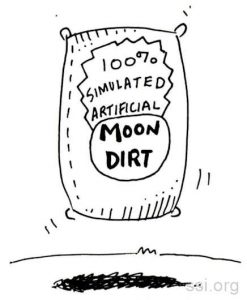
SSI Joins University of Colorado/NASA Center
The Space Studies Institute is a participant in a recently announced Space Engineering Research Center called The Center for Space Construction, at the University of Colorado in Boulder. This center was one of eight successful applicants out of over one hundred applications submitted to NASA for its Space Engineering Research Program. Some of the other participants in the Center For Space Construction are Ball Aerospace, BDM Corporation, Bechtel Construction, EG&G, External Tanks Corporation, and Martin Marietta Aerospace. This consortium will work together on space construction issues beginning in the first part of 1989.
Solar Power Satellite Thesis Available
SSI Senior Associate Todd Hawley has recently completed his Master’s thesis at George Washington University on the subject of Solar Power Satellites. It features the history of the solar power satellite concept and includes a Delphi survey of researchers in the U.S.A., Europe and Asia. The Delphi results indicate considerable optimism for commercial space solar power for use both in space and on Earth shortly after the turn of the century. The thesis also documents the present interest in SPS in Europe, the Soviet Union and Japan. Todd has agreed to make copies of this project available for a fee of $20 to cover the costs of duplicating, binding and mailing. If you would like a copy contact him directly c/o International Space University, 636 Beacon Street, Suites 201-202, Boston, MA 02215.
Office of Exploration
An excellent article appeared in the September issue of US News and World Report detailing the four scenarios under consideration during 1988 by the NASA Office of Exploration. These scenarios include a so-called sprint mission to the surface of Mars, a sprint mission to Phobos, a lunar far sight observatory which would be manned two weeks out of each year and a true lunar outpost which could be used as a stepping stone into deep space. This article has the clearest portrayal of each of these options that I have seen so far and I strongly recommend that you take a look at it.
New Harvest Video
The video tape version of the slide production New Harvest On The High Frontier is now available. This fourteen and one-half minute show produced by Rick Tumlinson is a powerful tool for explaining the work of the Institute and the relevance of space to the pressing energy and environmental problems faced by the Earth. This show has been getting excellent reviews from audiences as diverse as grade school students to groups of scientists and engineers. SSI Trustee, Jim Burke of The Jet Propulsion Laboratory recently showed it at the International Astronautical Federation World Meeting in Bangalore, India. The show was very well received. To get your own VHS copy send $25 to to the Institute.
Soviets Invite SSI Joint Projects
I have received an invitation to meet with leaders of the Moscow Aviation Institute in December. They have explained that the purpose of this expense paid trip is to discuss possible joint projects between our Institute and theirs. The Moscow Aviation Institute is the leading aerospace undergraduate and graduate school in the USSR. The Institute contains teams which work on construction of actual space hardware such as the ISKRA series of amateur radio satellites which are literally hand launched from the MIR space station. We have notified the State Department of our intention to accept this offer and I am presently making a list of people to contact while on the trip and engaging in such other practical preparations such as studying Russian on my way to and from the office and looking around for the long underwear that I have not worn since moving from Chicago several winters ago. We can be proud that the Institute is one of a handful of US organizations honored with invitations of this sort. (Others have included M.I.T. and Cal Tech, for example). If visas and other necessary details can be arranged, with luck, I will have a report in the March/April issue of Update. Till then best wishes to you and your families from the Directors, Officers and Staff of SSI.
Gregg Maryniak
PS: The President signed the Space Settlement Act on November 17!
©space studies institute
Back to the full list
NEXT: 1989 January-February (GKO’N on SPS)

